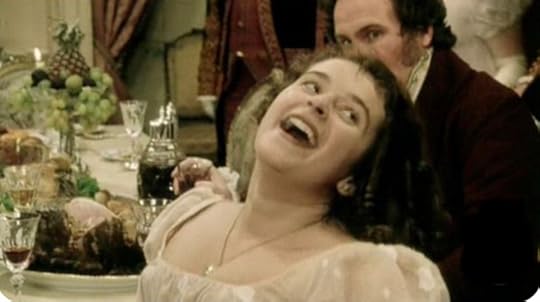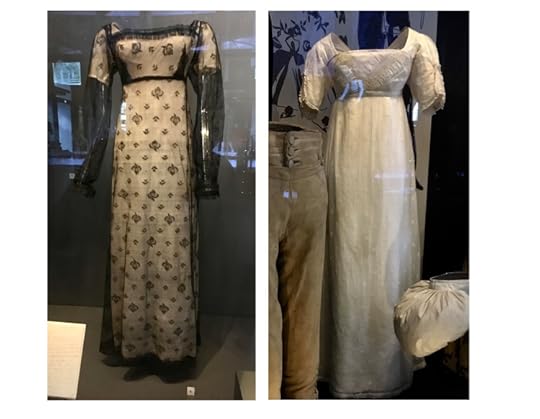Regency Garments: Deception of Appearance, Reality of Constraint
Have you ever envied a Recency woman? Prancing about her green English estate, clad as a Roman goddess, jiggling tummy hidden beneath layers of shear muslin, she lived for romance to make life complete.
 The Graces in a High Wind, James Gillray (1810), (taken at National Museum of Scotland)
The Graces in a High Wind, James Gillray (1810), (taken at National Museum of Scotland)Lydia, youngest and silliest of the Bennet sisters, gushed my favorite lines in the 1995 adaptation of Jane Austen’s book, Pride and Prejudice.(1) “Lord! Denny, fetch me a glass of wine, I can scarcely draw breath. I’m so fat.”
Weight didn’t seem to matter…Lydia was free to bounce and frolic…for plumpness was considered an indicator of health. Portraits of ample maidens in the National Art Gallery confirmed my understanding. ‘Hale’, ‘Bloom’ and ‘Vigour’ were Jane Austen’s complementary descriptions of heroines enjoying ‘food in good company’.(2)
Miss Austen did not write Lydia’s exclamation.
 Julia Sawalha as Lydia Bennet, Pride and Prejudice (1995)
Julia Sawalha as Lydia Bennet, Pride and Prejudice (1995)Andrew Davis added it to his 1995 screen adaptation, to illustrate the impropriety of the Bennett girls at the Netherfield Ball. Furthermore, upon researching that era, you soon discover that weight expectations of Regency women were no different than that of present-day. Under those billowing gowns, women were trussed up in corsets, that robbed them of both breath and movement, in effort to create a beautiful silhouette.

A Regency corset (also called a stay), was worn by both rich and poor. Though not as confining as the later Victorian version, it was formed of thick cotton quilting, tightly laced up the back, and with a prominent frontal wooden busk (flat stick of about 1 inch in width), positioned from the breasts to the lower abdomen.
 Regency corset (stay), front and back.
Regency corset (stay), front and back.A woman couldn’t dress alone, unless willing to be a ‘loose’ woman, for dressing required assistance of a ‘lacer’. It also left her unable to bend at the waist. (A shortened ‘stay’ was worn by working women of the lower classes.) Excellent posture was assured at the expense of her movement. Significance of the garment’s restraint is implied in Jane Austen’s writing.
Miss Bingley criticizes the Bennet girls’ ‘vulgarity’ and ‘indifference to decorum’ when she extols the attributes of a proper deportment: “…besides all this [a woman] must possess a certain something in her air and manners of walk, the tone of her voice, her address and expression…”
Deportment describes a person’s behaviour and manners. Undergarments constrained woman to enhance deportment. No slouching, leg crossing, thrusting of hips or free cavorting about. A loose fitting drawstring shift, worn under the corset, and two pantelettes (pulled up each leg, split at the middle, tied at the waist) were worn as underclothes(3) under dress and petticoat.
 Regency dresses, National Museum of Scotland
Regency dresses, National Museum of ScotlandTrussed up, with crotchless undergarments under thin muslin dresses, Regency woman of all classes were vulnerable.
In Regency England, marriage suspended the legal existence of a woman, consolidating her into that of her husband. She became a ‘non-person’ in the eyes of the law, a Feme Covert, where her legal right and obligation were subsumed by those of her husband.(4) ‘Covered’ by her husband, they were considered one person. As a result, all compacts were made void upon marriage, for her husband could not grant her anything, or even enter into a covenant with her for that would suppose her a separate entity, which she was no longer. The only exception was the Queen of England (both as queen consort or queen regnant).
A Feme Sole, an unmarried adult woman, was able to act on her own regarding estate and property—that is if she was fortunate enough to inherit.
Just like the Royal primogeniture laws, which were only altered in 2013 by the Succession of the Crown Act, male-line inheritance governed distribution of assets and titles.
Austen’s Pride and Prejudice follows the Bennet daughters’ desperation, for they have neither inheritance nor brothers to inherit. Their family estate will pass to a distant cousin, Mr. Collins, who condescends to marry one of the daughters to keep them from ruin, upon their father’s death.
This vulnerability has yet to be corrected. We can cast aside a baffling assortment of garters, sanitary belts, girdles, underwires, … and maintain respectability. We can even pursue a career or profession. Prevailing male primogeniture still governs inheritance of peerage and property. (5)
A deception of appearance remains.
I hurried upstairs, stripped off my clothes, including the cursed corset, and thrust them into the cold hearth to burn later. — Janet Blythe(6)
(1) Pride and Prejudice, Jane Austen, originally published 1813
(2) Jane Austen believed beauty could come in every shape and size. What else can she teach us about wellness? Bryan Kozlowski, March 12, 2019, Washington Post
(3) Corsets and Drawers: A Look at Regency Underwear, June 17, 2011, janeausten.co.uk
(4) Commentaries on the Laws of England, William Blackstone, Clarendon Press at Oxford, 1765
(5) Ladies first in Tory plan to abolish male primogeniture, Tom Newton Dunn, February,20, 2021, The Times
(6) Catherine Grove, Never Far (distributed through IngramSpark) 2020



